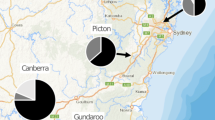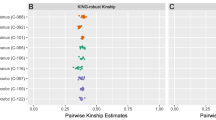Summary
Genetic structure ofCamponotus herculeanus populations was studied using both traditional allozyme markers and recently discovered DNA microsatellites. Relatedness among worker nest mates was high in one study population (0.70), but lower in another (0.48). The estimates lower than 0.75, together with the multilocus genotype patterns, indicate either multiple mating by queens, or multiple queens reproducing in the colonies. These two could not be distinguished with the current data, although multiple matings seem a more probable explanation for the relatedness estimates bearing social biology of the species in mind. Inbreeding coefficients suggested random mating in both populations. Both allozyme and DNA microsatellite markers gave the same result concerning genetic parameters estimated, but the higher variability of the microsatellites resulted in more precise estimates of both parameters.
Similar content being viewed by others
References
Boomsma, J. J. and A. Grafen, 1990. Intraspecific variation in ant sex ratios and Trivers-Hare hypothesis.Evolution 44:1026–1034.
Boomsma, J. J. and A. Grafen, 1991. Colony-level sex ratio selection in the eusocial Hymenoptera.J. Evol. Biol. 3:383–407.
Carlin, N. F., H. K. Reeve and S. P. Cover, 1993. Kin discrimination and division of labour among matrilines in the polygynous carpenter ant,Camponotus planatus. In:Queen number and sociality in insects (L. Keller, Ed.), Oxford University Press, Oxford, pp. 362–401.
Crozier, R. H. and P. Pamilo, 1996.Evolution of social insect colonies. Oxford University Press, Oxford (in press).
Don, R. H., P. T. Cox, B. J. Wainwright, K. Baker and J. S. Mattick, 1991. “Touchdown” PCR to circumvent spurious priming during gene amplification.Nuc. Ac. Res. 19:4008.
Evans, J. D., 1993. Parentage analysis in ant colonies using simple sequence repeat loci.Mol. Ecol. 2:393–397.
Fortelius, W., 1987. Different patterns of female behaviour in mono- and polydomousFormica populations. In:Chemistry and biology of social insects (J. Eder and H. Remboldt, Eds.), Verlag Peperny, München, pp. 293–294.
Gertsch, P., P. Pamilo and S.-L. Varvio, 1995. Microsatellites reveal high genetic diversity within colonies ofCamponotus ants.Mol. Ecol. 4:257–260.
Graur, D., 1985. Gene diversity in Hymenoptera.Evolution 39:190–199.
Hamilton, W. D., 1964. The genetical evolution of social behaviour. I.J. theor. Biol. 7:1–52.
van der Have, T. M., J. J. Boomsma and S. B. J. Menken, 1988. Sex investment ratios and relatedness in the monogynous antLasius niger (L.).Evolution 42:160–172.
Heinze, J., 1993. Habitat structure, dispersal strategies, and queen number in two borealLeptothorax ants.Oecologia 96:32–39.
Heinze, J., J. Gadau, B. Hölldobler, I. Nanda, M. Schmid and K. Scheller, 1994. Genetic variability in the antCamponotus floridanus detected by multilocus DNA fingerprinting.Naturwissenschaften 81:34–36.
Hölldobler, B., 1962. Zur Frage der Oligogynie beiCamponotus ligniperda Latr. undCamponotus herculeanus L. (Hym. Formicidae).Z. angew. Entomol. 49:337–352.
Hölldobler, B. and N. F. Carlin, 1985. Colony founding, queen dominance and oligogyny in the Australian meat antIridomyrmex purpureus.Behav. Ecol. Sociobiol. 18:45–58.
Keller, L., 1991. Queen number, mode of colony founding and queen reproductive success in ants.Ethol. Ecol. Evol. 3:307–316.
Keller, L., 1995. Social life: the paradox of multiple-queen colonies.Trends Ecol. Evol. 10:355–360.
Keller, L. and L. Passera, 1989. Size and fat contents of gynes in relation to the mode of colony founding in ants (Hymenoptera; Formicidae).Oecologia 80:236–240.
Nei, M., 1987.Molecular Evolutionary Genetics. Columbia University Press.
Pamilo, P., 1990. Comparison of relatedness estimators.Evolution 44:1378–1382.
Pamilo, P., 1991. Evolution of colony characteristics in social insects. 1. Sex allocation.Am. Nat. 137:83–107.
Pamilo, P. and R. Rosengren, 1984. Evolution of nesting strategies of ants: genetic evidence from different population types ofFormica ants.Biol. J. Linn. Soc. 21:331–348.
Queller, D. C., 1993. Genetic relatedness and its components in polygynous colonies of social insects. In:Queen number and sociality in insects (L. Keller, Ed.), Oxford University Press, Oxford, pp. 132–152.
Queller, D. C. and K. G. Goodnight, 1989. Estimating relatedness using genetic markers.Evolution 43:258–275.
Queller, D. C., J. E. Strassmann and C. R. Hughes, 1993. Microsatellites and kinship.Trends Ecol. Evol. 8:285–288.
Ratnieks, F. L. W., 1988. Reproductive harmony via mutual policing by workers in eusocial Hymenoptera.Am. Nat. 132:217–236.
Rosengren, R. and P. Pamilo, 1983. The evolution of polygyny and polydomy in mound-buildingFormica ants.Acta Entomol. Fennica 42:65–77.
Rosengren, R., L. Sundström and W. Fortelius, 1993. Monogyny and polygyny inFormica ants: the result of alternative dispersal tactics. In:Queen number and sociality in insects (L. Keller, Ed.), Oxford University Press, Oxford, pp. 308–333.
Ross, K. G., 1993. The breeding system of the fire antSolenopsis invicta, and its effects on colony genetic structure.Am. Nat. 141:554–576.
Ross, K. G. and D. J. C. Fletcher, 1985. Comparative study of genetic and social structure in two forms of the fire ant,Solenopsis invicta (Hymenoptera: Formicidae).Behav. Ecol. Sociobiol. 19:283–291.
Satoh, T., 1991. Behavioral differences of queens in monogynous and polygynous nests of theCamponotus nawai complex (Hymenoptera: Formicidae).Ins. Soc. 38:31–44.
Satoh, T., K. Masuko and T. Matsumoto, 1994. DNA fingerprinting in the monogynous and polygynous sibling species of ants,Camponotus nawai andCamponotus yamaokai. In:Les Insectes Sociaux (A. Lenoir, G. Arnold and M. Lepage, Eds.), Publications Université Paris Nord, Paris, pp. 514.
Seppä, P., 1992. Genetic relatedness of worker nestmates inMyrmica ruginodis (Hymenoptera: Formicidae) populations.Behav. Ecol. Sociobiol. 30:253–260.
Seppä. P., and L. Walin, 1996. Sociogenetic organization of the red antMyrmica rubra. Behav. Ecol. Sociobiol. (in press).
Seppä, P., L. Sundström and P. Punttila, 1996. Facultative polygyny and habitat succession in boreal ants.Biol. J. Linn. Soc. 56:533–551.
Sundström, L., 1993. Genetical population structure and sociogenetic organization inFormica truncorum.Behav. Ecol. Sociobiol. 33:345–354.
Sundström, L., 1995. Dispersal polymorphism and physiological condition of males and females in the ant,Formica truncorum, Behav. Ecol. 6:132–139.
Thorén, P. A., R. J. Paxton and A. Estoup, 1995. Unusually high frequency of (CT)n and (GT)n microsatellite loci in a yellowjacket wasp,Vespula rufa (L.) (Hymenoptera: Vespidae).Ins. Mol. Biol. 4:141–148.
Wright, S., 1951. The genetical structure of populations.Ann. Eugen. 15:323–354.
Author information
Authors and Affiliations
Rights and permissions
About this article
Cite this article
Seppä, P., Gertsch, P. Genetic relatedness in the antCamponotus herculeanus. A comparison of estimates from allozyme and DNA microsatellite markers. Ins. Soc 43, 235–246 (1996). https://doi.org/10.1007/BF01242925
Received:
Revised:
Accepted:
Issue Date:
DOI: https://doi.org/10.1007/BF01242925




